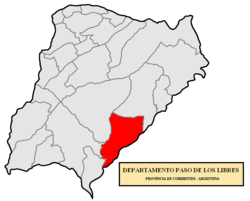Capybara (Hydrochoerus hydrochaeris) or as they are called in Uruguay, carpincho. Capybaras are found throughout much of South America and into Central America (Panama). Semi-aquatic, capybara frequent marshlands, feeding on grasses and aquatic plants. They live in social groups with a dominant male.
Capybaras are the world’s largest rodent, reaching up to 4 feet in length and up to 2 feet tall, weighing from 75 - 140 pounds. Looking a lot like giant guinea pigs, they are covered in sparse-looking brown fur. When startled, capybaras move into the cover of dense vegetation and can submerge for up to five minutes.
Carpinchos are hunted and eaten, their flesh is said to taste somewhat like pork. Capybara leather is used to make wallets, gloves, and other items. Their natural enemies are jaguar and caiman.
Goya is a city in the south-east of the province of Corrientes in the Argentine Mesopotamia. It has about 87,000 inhabitants as of the 2001 census [INDEC].
The city lies on the left-hand (eastern) shore of the Paraná River, opposite Reconquista, Santa Fe, 222 kilometres south from the provincial capital (Corrientes) and 715 kilometres north-northwest from Buenos Aires.
Goya hosts the annual National Festival of the Surubí, which includes a fishing contest. The surubí is a popular large catfish of the Paraná.
Origin of its name
The city of Goya does not have foundation act and, in agreement with the oral tradition, its name comes from a visionary and enterprising woman, nicknamed Doña Goya, who settled in the proximities of the present "costanera" (coast area), with a business of general goods, in the decade of 1790. It is said that this lady made exquisite cheeses, with the milk of cows fed with reedbeds and coconuts. Whoever made the stop at this zone, bought and spread their qualities by all the ports of Parana, popularizing the name of its manufacturer of such way, that already in 1801, this "place" was identified like "Goya Port". (Jose M. Cabrer).
Swallows
Every November 24 thousands of migratory swallows arrive at Goya, coming from San Juan Capistrano, California, from where they leave on October 23 and cross around 11,000 kilometres following the Pacific coast. When arriving to Goya, the swallows (golondrinas) are received with a series of festivals at the Monument to the swallows located in the San Martín Square, one of the places preferred by these small birds to nest. The return to Capistrano of the first swallow initiates around February 18, to arrive to California on March 19 every year. This particular event encouraged the communal heads of Goya and San Juan de Capistrano, to sign a declaration of brotherhood between the two cities.




No comments:
Post a Comment